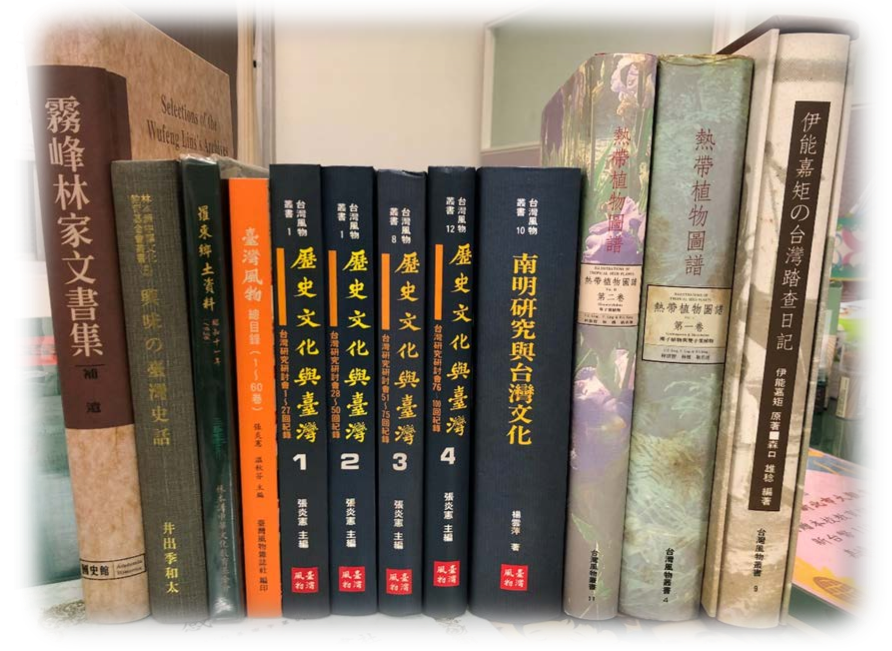
大船入港,快樂出航 - 基隆港的歷史
The History of Keelung Harbor
呂月娥/Lu Yueh-e
2001-10-29
 Keelung harbor and city after completion of urban renewal,
Keelung harbor and city after completion of urban renewal,
the straight-shore docks and square-grid road system.
基隆市區具有相當鮮明有緻的都市地景,穿越大業隧道進入市中心映入眼簾iris的就是海港、船艦的景象及海洋的氣息,但這個城市除了迷人的海岸景觀及著名的廟口小吃之外,背後還有一段豐富璀璨的發展歷史,甚至「港市合一」的理念早就已經由前人實現過了。本週台灣歷史之窗特別邀請中原大學近代建築與都市研究室研究員呂月娥帶我們一起回顧這段歷史,讓我們見識這個海港山城另一種偉大的面貌。
In physical appearance, Keelung City presents a distinctly contrasting multiplicity of textures. As you exit the Tayeh Tunnel and enter into the downtown area, what immediately jumps into your field of vision is the scene of harbor and ships, infused with maritime spirit. But besides the city’s enchanting harbor scenes and the famed eateries near the temples , Keelung has a rich and dazzling history of development, even long ago having achieved the ideal of organic oneness of port operations and city life. This week’s Window on Taiwan invites Lu Yueh-e, Research Fellow at the Chungyuan University Modern Architecture and Urban Research Institute, to help us appreciate another splendid aspect of this mountain town on the sea.
清朝時期的傳統基隆港市街
基隆在清朝雍正年間就有漢人移居內港,在蚵殼港、石硬港及田寮港所沖激出的沙洲上過著「耕漁並耦,雞狗相聞」的生活。道光年後,歐美勢力東移,基隆因豐富的煤礦資源及優越的港口條件而成為中外通商史上的重要港口,至此清朝政府開始認識基隆的重要性,除了將行政層級提升為基隆廳之外,並進行實質上的建設。
Keelung’s Ch’ing Dynasty-era traditional streets
During the Yung Cheng Reign Period of the Ch’ing Dynasty (1723-1736), ethnic Han Chinese immigrants settled in the Keelung region, living on the delta sand bars deposited by the rivers flowing into Keelung’s Hako Harbor, Shihying Harbor and Tienliac Harbor, living as farmers and fishermen in isolated communities with hardly any contact between them. When Europe and America began projecting their influence into the East Asia region during the Tao Kuang Reign Period (1821-1851), Keelung, because of its plentiful coal resources and excellent harbor conditions, became a major entrepot in the history of trade between China and other countries. For this reason, the Ch’ing government began noting Keelung’s importance and, besides upgrading its administative designation to “t’ing” or sub-prefect, also initiated substantive construction programs.
西元1885年(光緒11年)台灣首任巡撫劉銘傳上任後,首先遴委台灣首富林維源為基隆築港事宜的總辦,延聘外國工程師多人進行港灣測量及設計,計畫包含浚深內港深度、填埋新生地、建設運河及倉庫等港埠設施。再者,基於全台的商務、海防及運輸的需求,建設基隆至台北間的鐵道,其中獅球嶺隧道更成為中國鐵道史上的第一條隧道,而基隆至台北的鐵道於西元1891年(光緒17年)完工。第三項建設則為八斗子的西式官營煤廠,也是中國的第一座西式煤廠。而由於基隆自古就是台灣東北角一個易受盜匪及外國勢力介入的港口,在基隆地位日漸提昇之時,清廷自然加重了港口的軍事防衛,增建砲台、水雷局及增加駐兵等等。
After Liu Ming-chuan took office as Taiwan’s first governor under the Ch’ing Court in 1885 (Kuang Hsu Reign Period Year 11), he first recruited Taiwan’s wealthiest figure Lin Wei-yuan as the General Overseer of Keelung port construction projects. Subsequently, foreign engineers were hired to survey the harbor and set out a development blueprint, which included dredging the inner harbor, making landfills to extend the shoreline outward, plus construction of canals, warehouses and other port facilities. In addition, in consideration of the commercial, coastal defense and transport needs of Taiwan as a whole, construction of a Keelung-Taipei railroad was begun. As part of that project, the Shihchiuling Tunnel was the first example of tunnel construction in the history of Chinese railways. The railway link with Taipei was completed in 1891 (Kuang Hsu Year 17). A third major item of construction was the Western-style state-run coaling facility at Patoutzu, the first such Western-style facility in China. Moreover, inasmuch as Keelung had always been one of the locales on Taiwan’s northeast coast most vulnerable to the incursions of pirates and Western powers, in view of Keelung’s steadily growing importance, the Ch’ing government naturally took steps to bolster the port’s military preparedness, including building artillery emplacements, establishing a mine-laying authority, and beefing up its troop deployment.
可惜的是,這一連串的建設計畫在劉銘傳去職之後因無人繼承而荒廢,基隆港並未在這一階段的建設中全面近代化,市街仍維持傳統聚落的型式,人煙稠密而街道狹隘,加上終年風雨的氣候及市街的地勢低漥,而被形容為「瘴毒橫生」之處。
Alas, following Liu Ming-chuan’s departure from office this entire range of construction projects slipped into retrograde deterioration for want of a successor to promote them, resulting in Keelung Harbor’s failure to become completely modernized during this period of construction. Its streets were still those of a traditional village, its residents living in tightly packed quarters along narrow lanes. Adding to this condition was Keelung’s year-round rainy, windy weather and the low-lying topography of its streets, as a consequence of which it had a reputation for being a “breeding ground for pestilence.”
 Keelung Railway Station during the Japanese colonial era,
Keelung Railway Station during the Japanese colonial era,
the most important complex for land-sea shipment of cargoes to and from Keelung.
日治時期基隆港的興築過程
雖然清朝劉銘傳曾有意建設基隆港,但成果有限,真正推動基隆港邁入近代化歷程的時期應是在日治期間。西元1895年(明治28年)日本依馬關條約領有海外的第一個殖民地台灣,為了運送大量的人力及物資至此,總督府選擇了具有天然港口條件且區位最靠近日本的基隆港作為全台第一個實施港口現代化的港灣,從此基隆港市步入了有系統的近代化歷程。
Japanese colonial era construction process
While Liu Ming-chuan had endeavored to build up Keelung’s port facilities, his actual accomplishments in that regard were limited. The period in which it can be said that Keelung was truly impelled into a modern stage of development was the Japanese colonial era. Subsequent to the Treaty of Shimonoseki in 1895 (Year 29 in Meiji Era), by which Taiwan became Japan’s first overseas colony, in order to facilitate shipment of large quantities of manpower and materiel to Taiwan, the Japanese Viceroy’s Office selected Keelung, with its natural harbor and its closest proximity to Japan, as the first harbor or bay in Taiwan to undergo transformation into a modernized seaport. This marked the beginning of Keelung’s ongoing, systematic process of modernization.
台灣總督府相當看重基隆築港這項大工程,其重要性除了擔任台灣與日本間的主要聯絡港之外,更是日本展現其殖民能力的一個舞台,因此對於基隆築港所投入的時間、人力、經費為全台港口中最高者,基隆港在日治時期躍升為台灣航運之首要港。西元1896年(明治29年)日本領有台灣的第二年即成立了「基隆築港調查委員會」,參與計畫的技師皆具有築港及土木事業經驗,而在西元1898年(明治31年)評估將基隆港作為純商港使用,但是一旦面臨軍事需求時,商港將供作軍港使用。
The Viceroy’s Office in Taiwan placed great importance upon the large-scale port construction project in Keelung not only because of its importance as the primary port connecting Taiwan with Japan but because it could serve as a stage for demonstrating Japan’s capabilities as a colonial power. Consequently, the amounts of time, manpower and funds expended on Keelung port construction were the greatest for all of Taiwan, and Keelung became the premier port for Taiwan’s sea-borne trade. In 1896 (Meiji Year 29), the second year of Japan’s accession of Taiwan, the Keelung Port Construction Survey Commission was established, all of its participating technicians having had previous port construction and civil engineering experience. In 1898 (Meiji Year 31), it was planned that Keelung would serve as a purely commercial port, but with contingency plans for military applications should the need arise.
築港工程由西元1900年(明治33年)起至西元1945年(昭和20年)日本戰敗為止共46年之久,分為四期逐步推行。第一期築港工程因預算關係成果有限,內港在浚深工程之後可提供2艘3,000噸級的汽船進入裝卸貨,而浚深內港所產生的土砂則作為填埋新生地的用材,一共填埋出包含東岸小基隆等47,500坪的新生地。整體而言,基隆港的港灣潛力在這一階段尚未完全發揮。
Keelung port construction proceeded in 4 phases over a period of 46 years, from 1900 (Meiji Year 33) until 1945 (Showa Year 20), when Japan was defeated in World War II. Due to budgetary constraints, the first phase was limited in scope. After dredging of the inner harbor of the port, it could simultaneously handle the loading or unloading of two 3,000-ton class steamships. The dredged silt and stones were employed as landfill, in all creating 47,500 ping [1 ping = 36 square feet] of new land on the eastern shore of the bay in the areas of “Little Keelung” and other communities. As the result of this first phase, however, Keelung’s potential as a seaport had only begun to be developed.
西元1906年(明治39年)實施第二期築港工程,基隆港正式進入最大規模的內港整頓期,完成後基隆港以仙洞鼻防波堤為界區隔出內外港,內港海岸碼頭全數建設完畢,筆直的海岸碼頭及先進的運輸及倉儲設備,加上流經市區的三條河川整頓成可供運載貨物的運河,基隆港的貿易額取代淡水一躍成為全台第一。
With commencement of the second phase of the port construction project in 1906 (Meiji Year 39), Keelung Harbor formally entered upon the period of largest-scale revamping of its inner harbor. After Seawall construction was completed Keelung Harbor was divided, with Hsientungpi as a demarcation, into inner and outer harbors, and construction of all inner harbor docks was completed. With its long-stretching straight docks and its advanced onshore transport and warehouse facilities, together with hydraulic engineering performed on the three rivers running through the city enabling them to serve as canals, the volume of trade handled by Keelung Harbor leapt beyond that of Tamsui, taking its place as the number one seaport in Taiwan.
因貨物運送量不斷攀升,西元1929年(昭和4年)進入第三期築港工程,築港範圍由內港延伸至外港,並調整內港作為純商港使用,而在社寮島(現和平島)及八尺門間建設基隆漁港。西元1935年(昭和10年)進入第四期築港工程,此時在南進政策及太平洋戰爭的影響之下,興建了外港東西兩座防波堤及社寮島上大型的乾船塢以增加戰爭期間基隆港的運輸力。
Due to the ever-rising volume of shipping, a third phase of construction was launched in 1929 (Showa Year 4), during which the scope of facility development was extended to include the outer harbor, while the inner harbor was reorganized to handle purely commercial operations, and fishing ports were built at Sheliao Island (present-day Hoping Island) and Pachihmen. The fourth phase of construction was entered into in 1935 (Showa Year 10). Under the influence of Japan’s Southward Policy and subsequent war in the Pacific, and in order to augment Keelung Harbor’s shipping capacity during the war years, additional seawalls were built closer to the entrance of the outer harbor on its east and west sides, and a large-scale dry dock facility was constructed on Sheliao Island.
46年的築港過程將基隆港由一個漁村型態的港灣推向國際性的現代化港口,對基隆港的居民而言,不僅帶來了蓬勃的商機,更重要的,也促成基隆市街的改善。
Over this 46-year construction period, Keelung Harbor was catapulted from its original status as hardly more than a fishing village into the ranks of a modernized seaport on a par with world standards. For the people of Keelung, this development brought not only flourishing business opportunities but, more importantly, accelerated improvement of the city’s system of streets.
基隆港口都市的空間發展歷程
擁有日治時期全台最精進的港口設備,基隆港所吞吐的貨物量激增,原本以服務戎克船為主的傳統基隆市街已不符合使用,需要有快速的陸上運輸系統來進行貨物的接駁,加上原本地勢低漥的市街地層在海岸碼頭築砌之後,排水更加困難,因此為了改良市街衛生狀況,環境的整頓勢在必行,於是在「台北基隆市區計畫委員會」的認可下,西元1907年(明治40年)基隆實施了第一次的市區改正計畫,在填高之後的市街地盤上規劃棋盤式街廓系統,並興建公園、學校、市場、運河等都市公共設施。西岸規劃為港務專用區,包含深水碼頭、倉儲設備及火車站等皆位於此區,而南岸大基隆及東岸小基隆填埋新生地則作為市街使用。
Developmental process of Keelung’s urban space
In possession of the most advanced port facilities in Japanese colonial Taiwan, and experiencing a tremendous increase in the volume of goods which it swallowed and spit out, the traditional streets of the Keelung which had once been a mere service station for passing junks were no longer suited to the port’s needs. Given the need to establish a high-speed land-based transportation network for shipping goods to and away from the port, and because after construction of the docks ground water under the low-lying streets became even harder to expel, revamping of the environment to improve both city roads and public sanitation had become an imperative. Consequently, with the approval of the Taipei-Keelung Municipal Planning Commission, Keelung launched into its first-ever urban renewal project in 1907 (Meiji Year 40). After filling in lower-lying downtown areas, a grid-like road system was instituted, in addition to contruction projects for such public municipal facilities as parks, schools, markets, and canals. The harbor’s western shore was designated as a special zone reserved for harbor affairs. Deep-water docks, warehousing facilities and train station were all located in this zone. New land created by landfills along the harbor’s southern shore, or “Big Keelung,” and its eastern shore, or “Little Keelung,” were earmarked for new road construction.
對基隆人來說,這一階段的築港工程及市區改正的確造成生活型態上巨大的改變,是基隆港近代化最重要的奠基時期,目前基隆內港的都市空間大抵遵循此一土地使用架構。之後於西元1921(大正10年)及西元1937年(昭和12年)分別進行了市區擴張計畫及都市計畫,公共設施興築及土地建築管理的範圍隨著築港的範圍往外港延伸,都市脫離了初期實施市區改正的混亂與貧乏而逐漸步上軌道,基隆港的商機帶來大量的移入人口,基隆市因此擠入全台大都市之列,但西元1937年公佈的基隆都市計畫尚來不及全盤實施即因太平洋戰爭而擱置,未能看到另一次基隆港市大幅轉型的景象。
For the people of Keelung, the aforementioned period of port construction plus urban renewal most definitely had a huge ameliorative impact on living conditions, constituting the most important period in Keelung’s modernization process. And basically speaking, to this day districts hugging the inner harbor area continue to operate within the framework established at that time. Later, in 1921 (Taisho Year 10) and in 1937 (Showa Year 12) respectively, municipal expansion and city planning programs were embarked upon, as the consequence of which, the scopes of public infrastructure construction and land management were extended to the outer harbor regions. By then, the city had finally emerged from the turmoil and confusion of the urban renewal years, and city life gradually moved forward on an even keel. Business opportunities offered by Keelung attracted large numbers of newcomers, promoting Keelung into the ranks of Taiwan’s major metropolises. Before the city planning project initiated in 1937 could be fully implemented, however, it had to be put off due to the outbreak of the Pacific war, and since then, there have been no comparably large-scale alterations in appearance of harbor and city.
基隆港市在歷經清朝劉銘傳及日治時期台灣總督府的積極建設,其海運地位躍升為全台之首,市街空間及生活品質也逐步提昇,為現今的基隆港市奠下了重要的發展根基,更發展出了港與市共生共榮的緊密關係,但因市區腹地有限,目前基隆港市的發展遇到了瓶頸,期望未來港市的合作能在尊重基隆人文歷史及自然景觀的前提下,將基隆港推向另一個生命的高峰,讓這個美麗的海港山城再次成為台灣人驕傲的奇景。
Thanks to the active construction efforts beginning with Ch’ing Dynasty Governor Liu Ming-chuan and progressing onward with projects promoted by the Viceroy’s Office during the Japanese colonial era, the harbor and city of Keelung mounted to the top rank of maritime cities in Taiwan, and its streets and spaces plus its quality of life were also steadily enhanced, thus setting the foundation for present-day Keelung’s ongoing development, and evolving an organic intimacy between harbor operations and city life beneficial to their mutual prosperity. Keelung’s future development has now come to a bottleneck, however, owning to space limitations. Let us hope that future collaboration between harbor districts and city-at-large can, on the basis of respect for Keelung’s cultural legacy and natural environment, uplift it to a new peak in its life, enabling this gem of an ocean harbor cum mountain-embraced metropolis to reclaim its reputation as a wondrous vista of which all Taiwan’s people can be proud.
Edited by Tina Lee/ translated by James Decker
李美儀編輯/曹篤明翻譯









